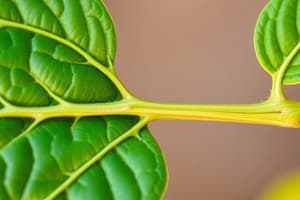Podcast
Questions and Answers
What is the primary function of xylem in plants?
What is the primary function of xylem in plants?
- To translocate organic materials, primarily carbohydrates, from sites of synthesis to storage sites or sites of metabolic demand
- To provide structural support to the plant
- To facilitate photosynthesis in the leaves
- To transport water and dissolved minerals from the root to the stem and aerial organs (correct)
What is the primary function of phloem in plants?
What is the primary function of phloem in plants?
- To transport water and dissolved minerals from the root to the stem and aerial organs
- To provide structural support to the plant
- To translocate organic materials, primarily carbohydrates, from sites of synthesis to storage sites or sites of metabolic demand (correct)
- To facilitate photosynthesis in the leaves
What is the main difference between tracheids and vessel elements in the xylem?
What is the main difference between tracheids and vessel elements in the xylem?
- Tracheids are longer and slender with overlapping vertical files, while vessel elements are short and wide with perforated end walls (correct)
- Tracheids have thick, lignified cell walls, while vessel elements have thin, non-lignified cell walls
- Tracheids are found in both angiosperms and gymnosperms, while vessel elements are only found in angiosperms
- Tracheids are responsible for transporting water, while vessel elements are responsible for transporting dissolved minerals
What is the driving force behind the upward movement of water through the xylem?
What is the driving force behind the upward movement of water through the xylem?
Which of the following statements about the structure of xylem is true?
Which of the following statements about the structure of xylem is true?
What is the primary difference between xylem and phloem in terms of the materials they transport?
What is the primary difference between xylem and phloem in terms of the materials they transport?
What is the primary function of xylem?
What is the primary function of xylem?
What is the primary function of phloem?
What is the primary function of phloem?
What characteristic of sieve elements in phloem makes them solely dependent on surrounding parenchyma cells for maintenance?
What characteristic of sieve elements in phloem makes them solely dependent on surrounding parenchyma cells for maintenance?
What is the relationship between xylem and phloem in the plant?
What is the relationship between xylem and phloem in the plant?
What happens to the primary phloem as the plant grows?
What happens to the primary phloem as the plant grows?
What is the purpose of the cohesion-tension theory in relation to xylem transport?
What is the purpose of the cohesion-tension theory in relation to xylem transport?
Flashcards are hidden until you start studying
Study Notes
Plant Tissue: Xylem and Phloem
Overview
Xylem and phloem are two vital components of plant tissue that play crucial roles in the functioning of the plant. Xylem, often referred to as wood, is a type of vascular tissue responsible for transporting water and dissolved minerals from the root to the stem and aerial organs. On the other hand, phloem is another type of vascular tissue that translocates organic materials, primarily carbohydrates, from sites of synthesis to storage sites or sites of metabolic demand.
Xylem
Xylem is a complex tissue made up of a long chain of small tubes, called vessels, which interconnect and allow water to travel through unimpeded. These vessels are supported by other cells that help pull nutrients from the water and transport them to cells within the leaves. The water is propelled upward through the xylem due to pressure at the base of the plant and a phenomenon called transpiration, where water evaporates from the leaf surfaces, pulling more water upwards.
There are two main types of tracheary elements in the xylem: tracheids and vessel elements. Vessel elements, found in angiosperms, are short and wide with perforated end walls that form perforation plates at each end of the cell. Tracheids, present in both angiosperms and gymnosperms, are longer and slender with overlapping vertical files. Both types of tracheary elements are dead cells with thick, lignified cell walls, forming hollow tubes through which water flows efficiently.
Water moves through the xylem via pressure-driven bulk flow, which does not depend on solute concentration gradients and is independent of gravity. Interestingly, the cohesion-tension theory explains how water is pulled from the root to the shoot against gravity, despite water being attracted towards lower energy states (gravity).
Phloem
Unlike xylem, phloem's primary function is the transport of organic materials, particularly sugars, from sites of synthesis to storage sites or sites of metabolic demand. Phloem is typically composed of three cell types: sieve elements, parenchyma, and sclerenchyma. Sieve elements are the primary conductors of sugars and are characterized by having lost their nuclei and other organelles, making them solely dependent on surrounding parenchyma cells for maintenance. These parenchymatous cells support the sieve elements and contribute to the overall function of phloem.
In plants with secondary growth, the secondary phloem is formed, causing the primary phloem to collapse. Secondary phloem is continuously generated, reducing the lifespan of sieve elements within the phloem. Despite its role in sugar transport, phloem plays other roles in the plant body, serving as a pathway for signaling molecules such as mRNAs, hormones, and defense compounds from biotic and abiotic stresses.
Xylem and Phloem Interactions
At specific points, the xylem extends small tubes into the phloem, allowing for efficient exchange of nutrients and other compounds between the two tissues. Although xylem brings water and minerals up from the roots, it works in conjunction with phloem to distribute organic materials throughout the plant.
Studying That Suits You
Use AI to generate personalized quizzes and flashcards to suit your learning preferences.




